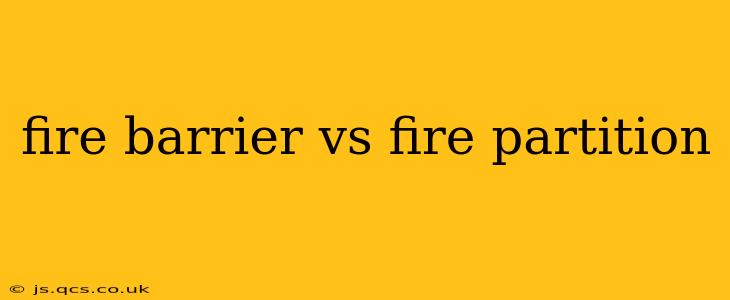Choosing the right fire-resistant construction is crucial for building safety. While both fire barriers and fire partitions aim to restrict the spread of fire, they differ significantly in their performance and application. This article clarifies the distinctions between fire barriers and fire partitions, answering common questions to help you make informed decisions about fire safety in your building.
What is a Fire Barrier?
A fire barrier is a fire-resistant assembly designed to prevent the spread of fire and smoke between different areas of a building for a specified period. Think of it as a more robust and comprehensive form of fire protection. It's typically used to separate larger sections of a building, often with different occupancies or fire zones, offering a higher level of protection. Fire barriers are designed to withstand significantly higher temperatures and longer fire durations compared to fire partitions.
What is a Fire Partition?
A fire partition, on the other hand, is a fire-resistant assembly used to compartmentalize smaller areas within a building. It provides a lower level of fire protection than a fire barrier, typically restricting the spread of fire for a shorter duration. They're commonly employed to divide spaces within a single occupancy, like offices in a commercial building, or apartments within a multi-unit dwelling.
What are the Key Differences Between Fire Barriers and Fire Partitions?
The fundamental differences lie in their fire resistance rating, construction, and intended use:
-
Fire Resistance Rating: Fire barriers generally have higher fire resistance ratings (measured in hours) than fire partitions. This signifies their ability to withstand fire exposure for a longer period.
-
Construction: Fire barriers usually incorporate more robust construction materials and methods, resulting in a more substantial and durable assembly. They might require more extensive penetration firestopping to maintain integrity.
-
Application: Fire barriers are used for major separations within a building, while fire partitions are used for smaller-scale compartmentalization.
-
Extent of Protection: Fire barriers offer greater protection against the spread of both fire and smoke, acting as more significant firebreaks. Fire partitions provide a degree of fire protection but are not designed to withstand the same level of intense heat and fire duration.
How Do Fire Barriers and Partitions Impact Building Codes?
Building codes and regulations dictate the required fire resistance ratings and the appropriate use of fire barriers and partitions based on the building's occupancy, size, and other factors. These codes are crucial for ensuring life safety and property protection. Always consult your local building codes and fire regulations.
What are the Common Materials Used in Fire Barriers and Partitions?
Common materials include fire-rated drywall, concrete, and specialized fire-resistant insulation. The specific materials used will vary depending on the desired fire resistance rating and the intended application.
What is the Difference in Cost Between Fire Barriers and Fire Partitions?
Generally, fire barriers are more expensive to install than fire partitions due to their higher fire resistance rating and more stringent construction requirements. The cost difference will vary based on the specific materials and labor involved.
How are Fire Barriers and Fire Partitions Tested?
Both fire barriers and partitions undergo rigorous testing to ascertain their fire resistance ratings. These tests simulate real-world fire conditions to determine how long they can resist fire penetration and heat transfer.
In summary, understanding the differences between fire barriers and fire partitions is crucial for ensuring building safety. The appropriate choice depends on the specific requirements of the building and its intended use, always adhering to local building codes and regulations. Consulting with fire protection engineers and building professionals ensures compliance and optimal protection.
